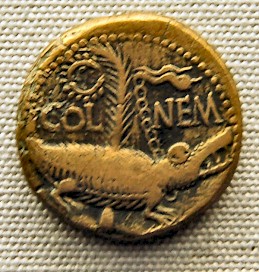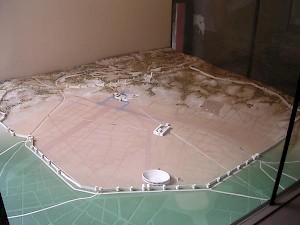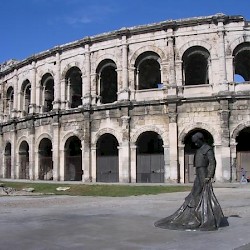Nemausus (Nîmes)
Q2914723Nemausus (Νέμαυσος): Roman city in southern France, modern Nîmes.
Origin

The ancient city of Nemausus, which was (according to Greek geographer Strabo) the capital of the Gallic tribe of the Volcae,note was situated on the southern edge of the Cevennes Mountains (Mons Cebenna) in a fertile part of the valley of the Lower Rhône. The towns was named after an ancient Gallic god, Nemausus, who was venerated in a sacred well in the northwestern part of the city.
The Romans gained control of this part of Gaul during the Second Punic War but started to develop this part of their empire in 118 BCE, about a century later, when they built the Via Domitia. This road connected Italy to Hispania. According to Strabo, the road was "easy to travel in summer, but muddy and flooded by the rivers in winter and spring". This may have been especially true for the countryside of Nemausus, where water is abundant.
Empire
In 27 BCE, the emperor Augustus settled veterans from his Egyptian campaign in the city and gave it the rights of a colonia. (Alternatively, they were soldiers of the army of his defeated rival Mark Antony.)) As a consequence, the coins of Nemausus showed an Egyptian crocodile and sometimes palm tree or leaf.

Eleven years later, the emperor also surrounded the city with a wall (length six kilometers; nine meters high), in which several older monuments were included. One of these was the Tour Magne. The original function of this Gallic building is not known, but it may have been a mausoleum, a watchtower, or a sanctuary.
Another part of the new wall was the Gate of Augustus (Porte d'Auguste) in the southeastern part of the enceinte. This gate was originally called Porta Arelatensis ("Gate to Arles"), but has in the past also had such illustrous names as Porte de France and Porte d' Espagne. The monument was built in 16 or 15 BCE and consists of two main arches, which were probably designed to separate traffic and make it keep its lane. Two small arches to the left and right were meant for pedestrians.
Another early monument was the temple of Augustus and Roma, which is now known as the Maison Carrée, the "square house". A generation later, the sanctuary of the god Nemausus was restored.

The city received an aqueduct, that takes in its waters near Uzès (ancient Ucetia), almost 50 km away from the city; the famous Pont du Gard is part of this aqueduct. The castellum, where the aqueduct ended and the waters were divided, has also survived (château d'eau). During the Flavian emperors (69-96), the amphitheater was built, which is still in use for bullfights. It is about 133 m long and 101 m wide, and has a capacity of about 16,000 people.
The emperor Hadrian added a basilica, which was named after Plotina, wife of Trajan; according to the Historia Augusta, it was "of marvellous workmanship".note
The city may have had as many as 50,000 or even 60,000 inhabitants, which is about as many as Nîmes had in the mid-nineteenth century. It was a fairly cosmopolitan city: for instance, there was a cult of the Jupiter Heliopolitanus, whose main cult center was in Baalbek in what is now Lebanon.
Decline
The decline of Nemausus appears to have started early: the city was eclipsed by Arles, which was, in the fourth century, the largest city in southern Gaul. It is probably no coincidence that we do not hear of a Christian community until the sixth century: Nemausus had become a very small town indeed. Still, in the sixth century, it was the resicence of the Visigothic rulers, who used the Maison Carrée as their palace.
In the Middle Ages, the city was largely abandoned, except for the part near the amphitheater, which had been turned into a fortress by the viscounts of Nîmes.







